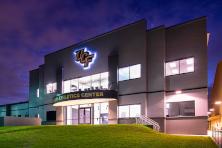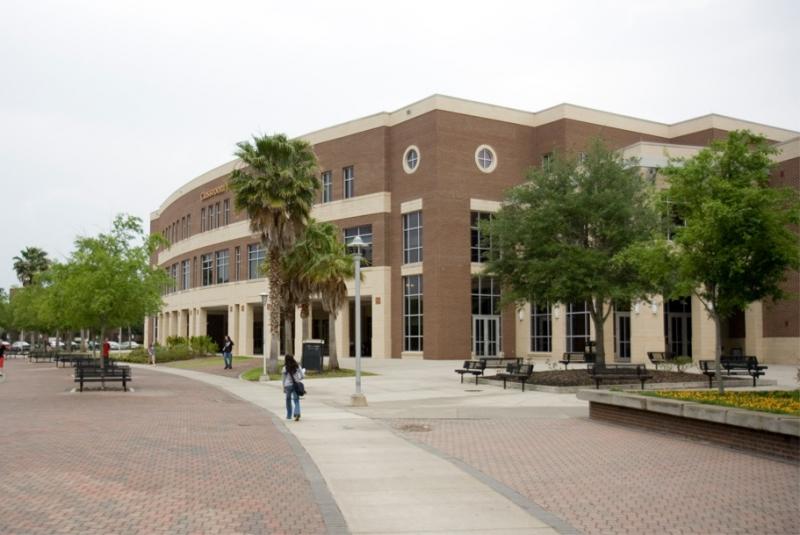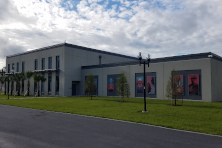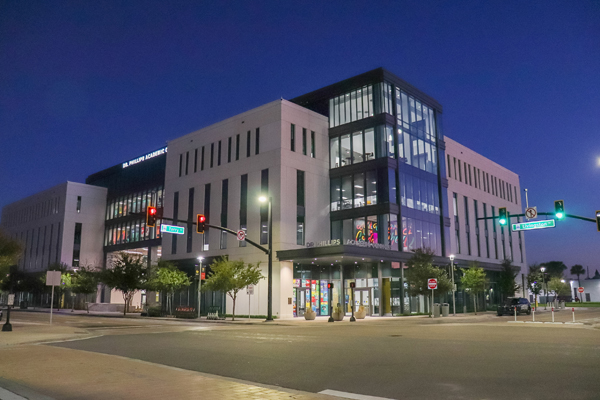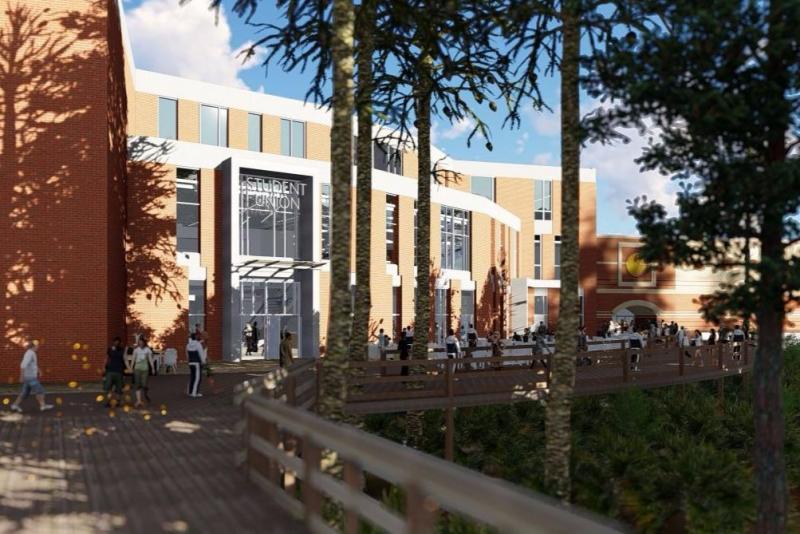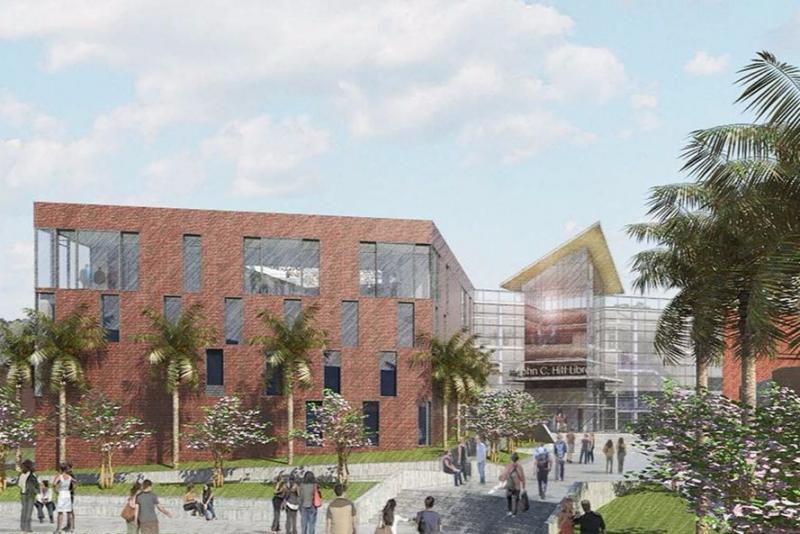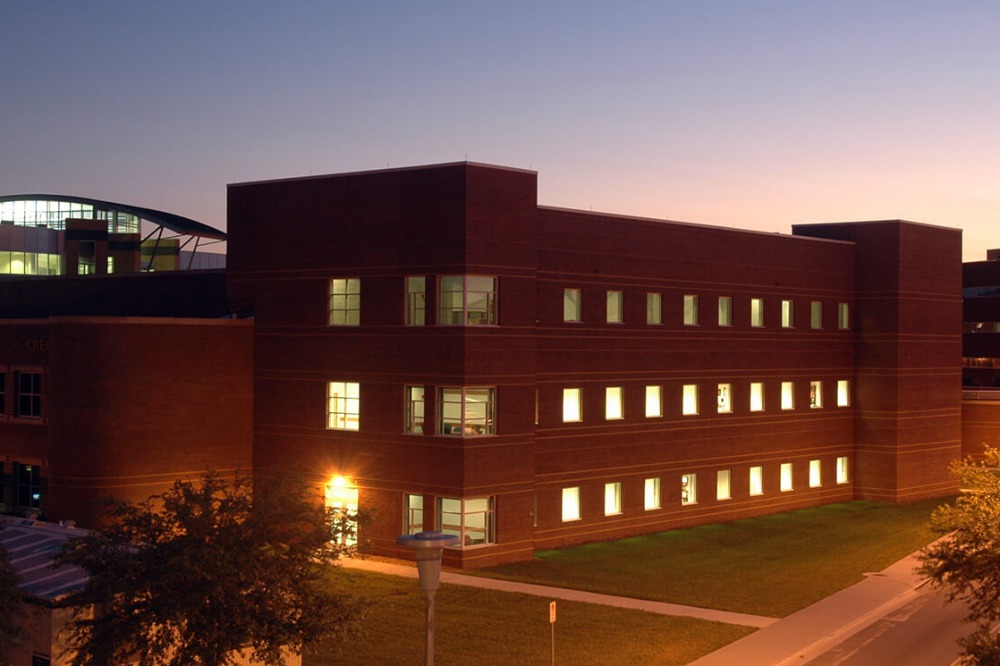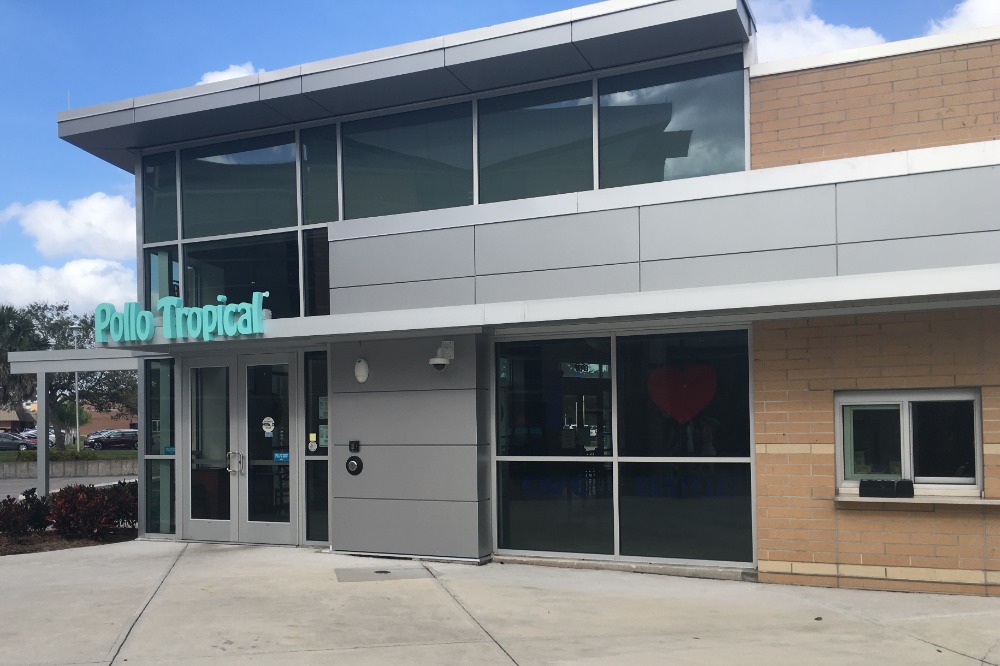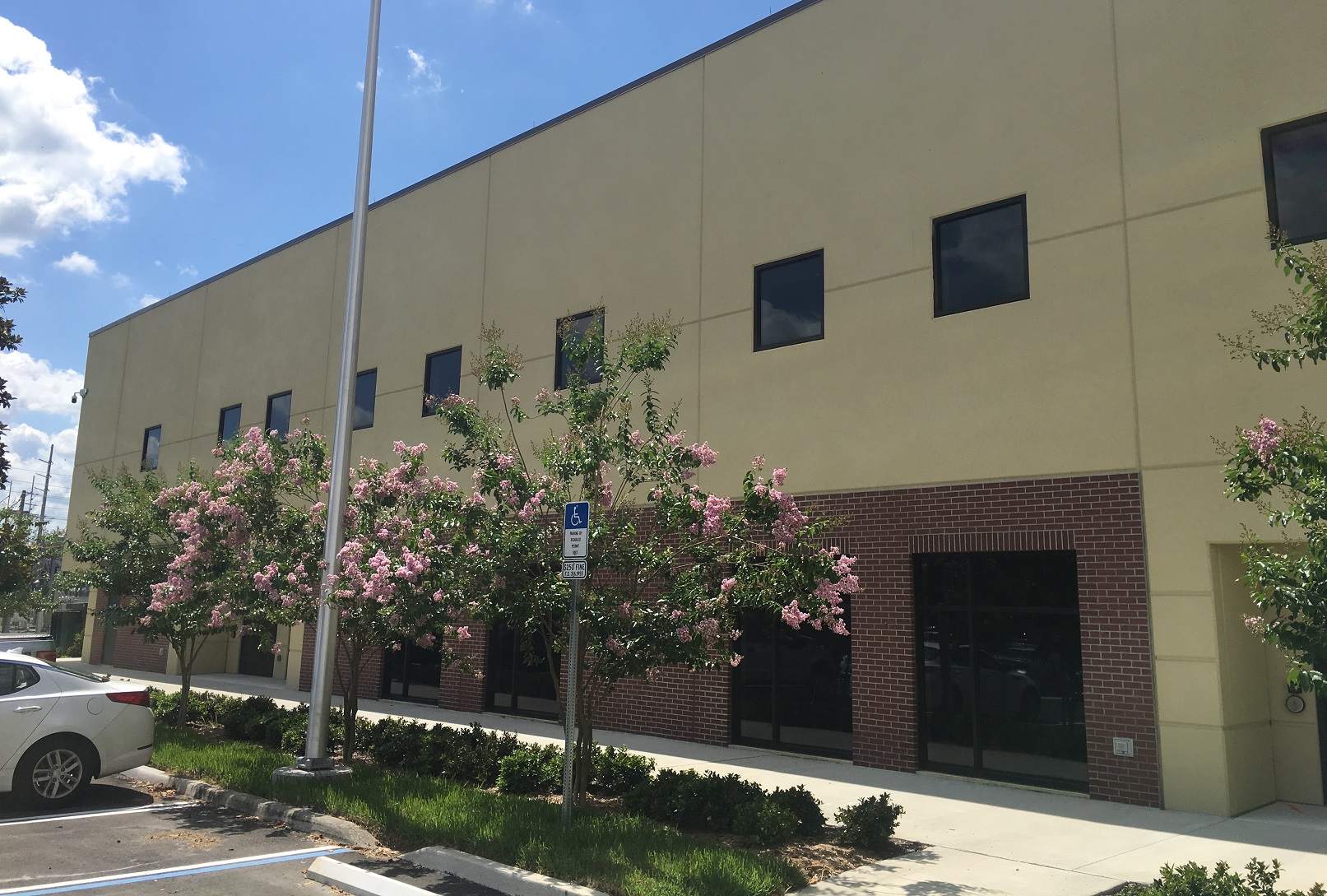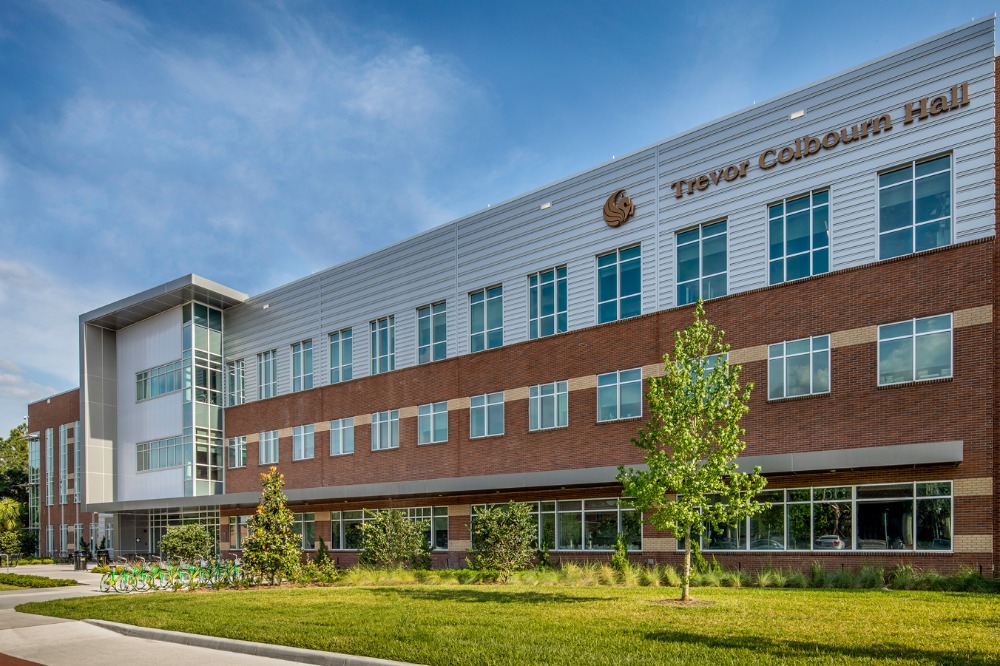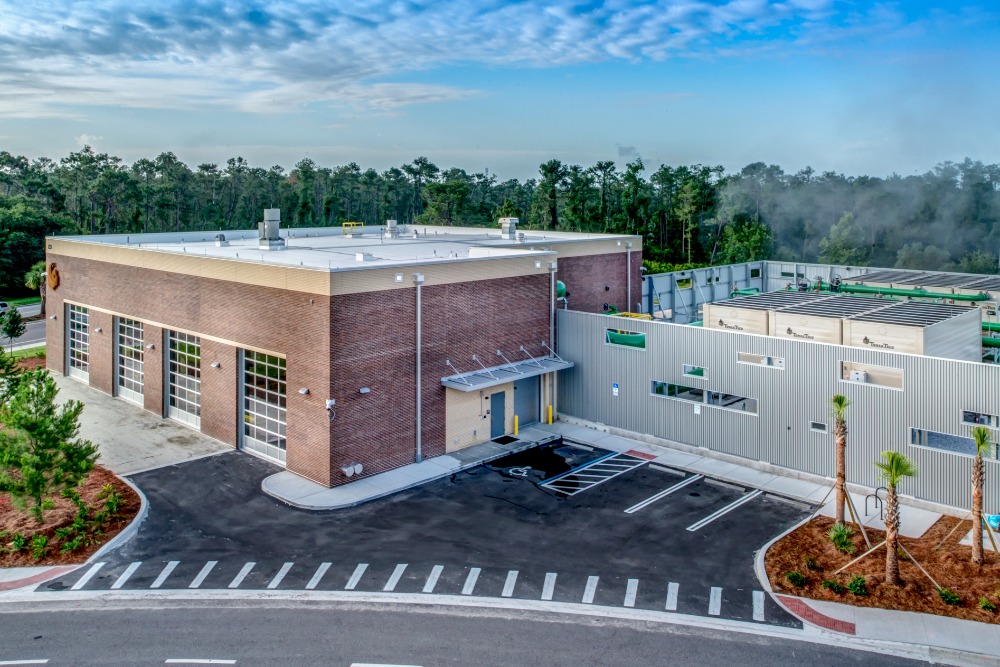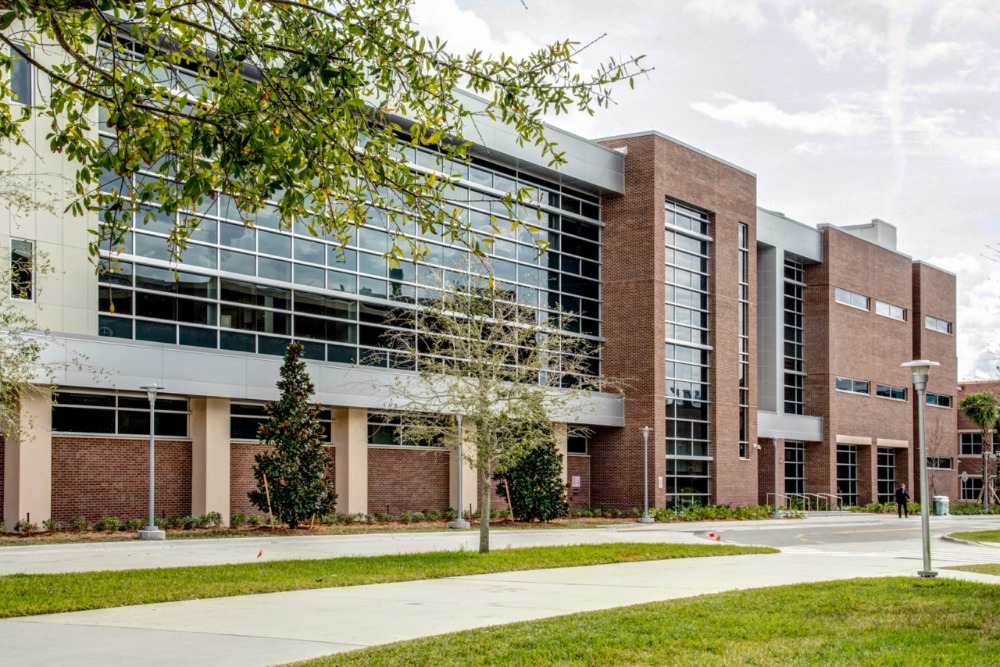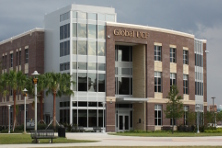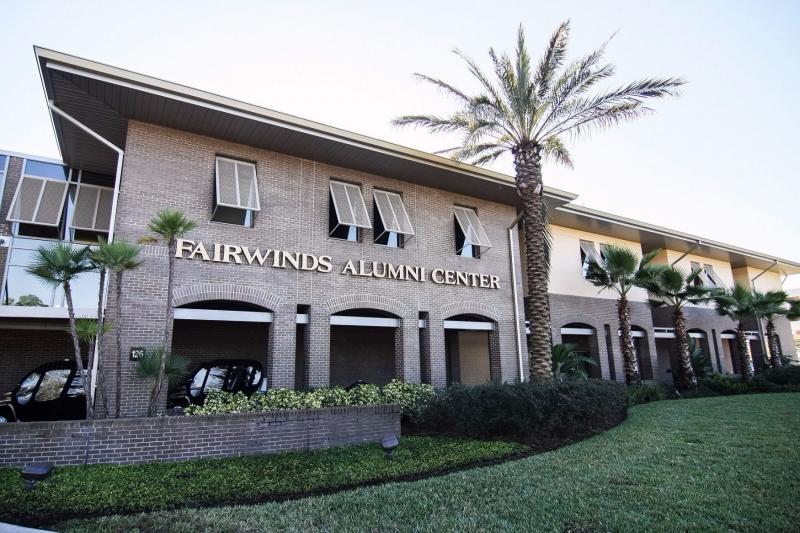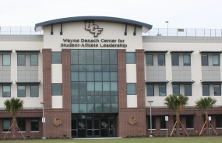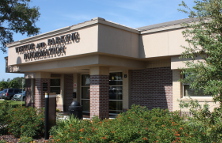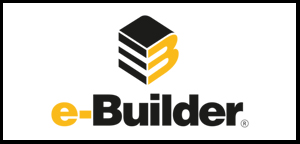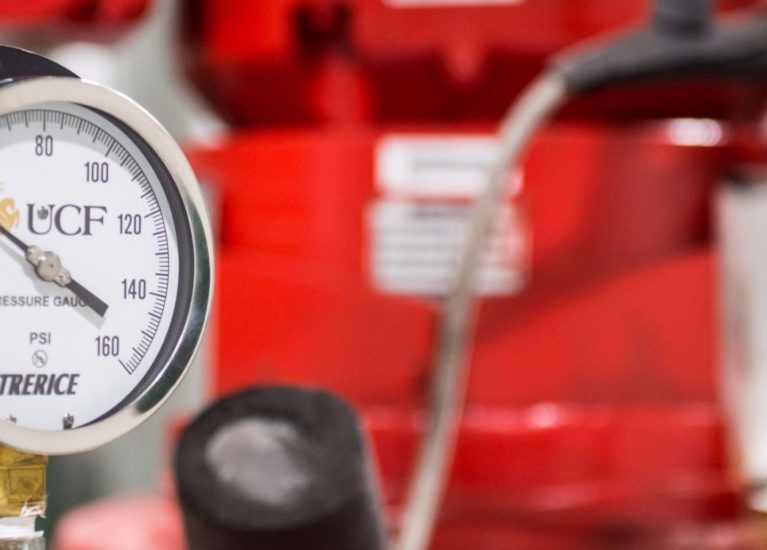
High Performance Buildings
30 Buildings Certified with LEED: 21 LEED Gold & 7 LEED Silver at 1.3 Million Square Feet
High performance buildings play an integral role in UCF’s learning environment. As UCF continues to grow, our objectives include reducing the impact of buildings on the environment and human health. The U.S. Green Building Council’s LEED® green building program is the preeminent program for the design, construction, maintenance and operations of high-performance green buildings. Like many of our peer institutions, UCF mandates LEED® certification for all new construction and major renovations through 28 credits incorporated in the Green Building Construction and Renovation Requirements with emphasis on energy, atmosphere, and water efficiency.
Why LEED?
LEED® buildings use about 30% less energy and 40% less water than their counterparts and promote occupant health and productivity through indoor air quality, mindful building materials, lighting, biophilia, and the alike. These mechanisms are surveyed and refined to ensure optimal occupant comfort upon pursuit of subsequent building certification. The UCF Collective Impact Strategic Plan highlights “the importance given to ensuring that the university strengthens its commitment to healthy environments and sustainable practices in everything it undertakes” (p. 30). LEED®’s evolving stringent standards, paired with aggressive energy strategies, can ultimately transform UCF into a healthier campus.
UCF has employed the LEED® Campus approach that documents applicable prerequisites and credits once that apply to the entire campus. The credits earned at the campus level are available to all individual LEED projects within the main campus boundary for future new construction and existing building certifications. View the LEED Main Campus Credit Guide and the LEED Downtown Campus Credit Guide for more information.
UCF FAIRWINDS Alumni Center was the first LEED® Gold project under the v4 O+M rating system at UCF with the help of many stakeholders and its occupants. View the UCF FAIRWINDS Alumni Center Case Study.
| LEED Scorecard | |
|---|---|
| UCF Downtown: CEP | |
| LEED BD+C: New Construction (v2009) | |
| Certification awarded Feb 2020 | |
| Gold | 62 |
| Sustainable sites | 24/26 |
| Water efficiency | 2/10 |
| Energy & atmosphere | 13/35 |
| Material & resources | 6/14 |
| IEQ | 11/15 |
| Innovation | 5/6 |
This project is connected to various basic services that are open for public use. An alternative transit option is located within a one-half mile walking distance. Bicycle storage facilities are provided for 50% of occupant and shower facilities for 33% of the peak occupant count. Preferred parking for low-emitting and fuel-efficient vehicles, and for carpool vehicles, is provided for 50% of the total parking capacity. Storm water runoff from 90% of the average annual rainfall is captured and treated to remove 80% of the average annual post-development Total Suspended Solids (TSS). 100% of the building roof surface and 87% of nonroof base has a Solar Reflectance Index of at least 29 to reduce heat island effect.
Water Efficiency: 2 points
The project has reduced potable water use by 32.67%.
Energy and Atmosphere: 13 points
The project has an energy cost savings of 27.62%. Enhanced commissioning has been implemented. The project selected refrigerants and HVACR systems that minimize or eliminate the emission of compounds that contribute to ozone depletion and global climate change. Additionally, all fire suppression systems in the LEED project do not use ozone-depleting substances including CFCs, HCFCs, or halons. The refrigerant impact calculation indicates that the total refrigerant impact of the LEED project is 10.07 per ton, which is less than the maximum allowable value of 100.
Materials and Resources: 6 points The project diverted 90.41% of the on-site generated construction waste from landfill. 22.29% of the total building materials content, by value, has been manufactured using recycled materials. 37.34% of the total building materials value includes materials and products that have been manufactured and extracted within 500 miles of the project site.
Indoor Environmental Quality: 11 points
The project is mechanically ventilated and outdoor air ventilation rates have been increased by at least 30% above minimum rates required by ASHRAE 62.1-2007. Smoking is prohibited within 25 feet of entries, outdoor air intakes, and operable windows. Additionally, smoking is prohibited within the building. The project reduces air quality problems resulting from construction to promote the comfort and well-being of construction workers and building occupants. All adhesive and sealant products, paint and coating products, interior flooring materials, and composite wood and agrifiber products used on the inside of the weatherproofing system and applied on-site contributing to the overall VOC Budget is equal to or below the required standard. The project has been designed to minimize building occupant exposure to potentially hazardous particulates and chemical pollutants. Lighting controls are provided for 100% of building occupants to enable adjustments that meet needs and preferences. The mechanically ventilated and mechanically conditioned project space is in compliance with ASHRAE 55-2004, a permanent monitoring system will be installed, and a thermal comfort survey of building occupants will be conducted between six and 18 months after occupancy. The project has provided direct line of sight views from 100% of all regularly occupied spaces.
Innovation in Design: 5 points The project has developed and implemented an ID credit proposal in compliance with LEED-EB OM v4: Purchasing – Lamps, which sets a maximum threshold of 35 picograms of mercury per lumen-hour, or less, for all mercury-containing lamps purchased for the building and associated grounds within the project boundary. The project has developed and implemented a Green Housekeeping program. The project has developed and implemented a Public Education program.
| LEED Scorecard | |
|---|---|
| UCF Downtown: Dr. Phillips Academic Commons | |
| LEED BD+C: New Construction (v4) | |
| Certification awarded October 2021 | |
| Gold | 61 |
| Location and Transportation | 13/16 |
| Sustainable sites | 3/10 |
| Water efficiency | 3/11 |
| Energy & atmosphere | 21/33 |
| Material & resources | 4/13 |
| IEQ | 9/16 |
| Innovation | 5/6 |
| Regional Priority Credits | 3/4 |
The project protects sensitive land by building on a previously developed site. The project is surrounded by high density building practices and is connected to various basic services that are open for public use. An alternative transit option is located within a one-half mile walking distance.
Sustainable Sites: 3 points
The building roof and nonroof surfaces have a Solar Reflectance Index of at least 29 to reduce heat island effect.
Water Efficiency: 3 points
The project uses landscaping requiring no or low amounts or irrigation. It also reduces potable water use by 31.49% compared to a baseline building. The campus uses water efficient cooling towers for chilled water production.
Energy and Atmosphere: 21 points
Community solar is used to supply 90% of the electricity to the building. The project has an energy cost savings of 35.4% compared to a baseline building. Enhanced commissioning has been implemented. The three largest end use savings contributors are Space Cooling, Space Heating, and Interior Lighting. Interior lighting energy use is reduced in the proposed design by three main factors: 1) Lower design LPD while meeting spacing needs, 2) occupancy sensors or programmable timers, and 3) daylighting placed in spaces.
Materials and Resources: 4 points The project reported environment product declarations and material ingredients to demonstrate optimal product sustainability. The project diverted 86.26% of the on-site generated construction waste from landfill.
Indoor Environmental Quality: 9 points
The project uses an innovative filtration system to reduce required outside air by removing contaminants from the building. Smoking is prohibited within 25 feet of entries, outdoor air intakes, and operable windows. Additionally, smoking is prohibited within the building. The project reduces air quality problems resulting from construction to promote the comfort and well-being of construction workers and building occupants. Lighting controls are provided for 100% of building occupants to enable adjustments that meet needs and preferences.
Innovation in Design: 5 points
The site walkability and filtration system provided additional credits.
Regional Priority Credits: 3 points
A number of the awarded credits provided additional points for being regional priorities.
| LEED Scorecard | |
|---|---|
| UCF Student Union Expansion | |
| LEED BD+C: New Construction (v4) | |
| Certification awarded June 2021 | |
| Certified | 40 |
| Location and Transportation | 7/16 |
| Sustainable sites | 3/10 |
| Water efficiency | 5/11 |
| Energy & atmosphere | 10/33 |
| Material & resources | 4/13 |
| IEQ | 3/16 |
| Innovation | 3/6 |
The project protects sensitive land. The project is surrounded by high density building practices and is connected to various basic services that are open for public use. An alternative transit option is located within a one-half mile walking distance. No additional parking was added for this project, and therefore achieved the Reduced Parking Footprint credit.
Sustainable Sites: 3 points
The project practiced pollution prevention during construction. The building roof and nonroof surfaces have a Solar Reflectance Index of at least 29 to reduce heat island effect.
Water Efficiency: 5 points
The project uses 100% reclaimed water for outdoor water use purposes. It also reduces potable water use by 40.36% compared to a baseline building.
Energy and Atmosphere: 10 points
The project has an energy cost savings of 18.9% compared to a baseline building. Enhanced commissioning has been implemented. The three largest end use savings contributors are Space Cooling, Space Heating, and Interior Lighting. Interior lighting energy use is reduced in the proposed design by three main factors: 1) Lower design LPD while meeting spacing needs, 2) occupancy sensors or programmable timers, and 3) daylighting placed in spaces. The envelope performance for the addition exceeds minimum requirements resulting in reduced energy usage.
Materials and Resources: 4 points The project reported environment product declarations and material ingredients to demonstrate optimal product sustainability. The project diverted 89.58% of the on-site generated construction waste from landfill.
Indoor Environmental Quality: 3 points
The project is mechanically ventilated and outdoor air ventilation rates have been increased by at least 30% above minimum rates required by ASHRAE 62.1-2010. Smoking is prohibited within 25 feet of entries, outdoor air intakes, and operable windows. Additionally, smoking is prohibited within the building. The project reduces air quality problems resulting from construction to promote the comfort and well-being of construction workers and building occupants. Lighting controls are provided for 100% of building occupants to enable adjustments that meet needs and preferences.
Innovation in Design: 3 points
The project has developed and implemented a Green Housekeeping program and had a LEED Accredited Professional on the certification team.
| LEED Scorecard | |
|---|---|
| UCF CREOL Expansion | |
| LEED BD+C: New Construction (v2009) | |
| Certification awarded Jan 2020 | |
| Gold | 62 |
| Sustainable sites | 19/26 |
| Water efficiency | 4/10 |
| Energy & atmosphere | 22/35 |
| Material & resources | 5/14 |
| IEQ | 10/15 |
| Innovation | 3/6 |
This project is connected to various basic services that are open for public use. An alternative transit option is located within a one-half mile walking distance. The open space provided is equal to or greater than the footprint of the LEED project building. Storm water runoff from 90% of the average annual rainfall is captured and treated to remove 80% of the average annual post-development Total Suspended Solids (TSS). 100% of the building roof surface and 90% of non-roof base has a Solar Reflectance Index of at least 29 to reduce heat island effect.
Water Efficiency: 4 points
The project has water efficient landscaping that reduced potable water usage by 100%.
Energy and Atmosphere: 22 points
The project has an energy cost savings of 44.9%. Enhanced commissioning has been implemented. The project selected refrigerants and HVACR systems that minimize or eliminate the emission of compounds that contribute to ozone depletion and global climate change. Additionally, all fire suppression systems in the LEED project do not use ozone-depleting substances including CFCs, HCFCs, or halons. The refrigerant impact calculation indicates that the total refrigerant impact of the LEED project is 90 per ton, which is less than the maximum allowable value of 100.
Materials and Resources: 5 points The project diverted 53% of the on-site generated construction waste from landfill. 14% of the total building materials content, by value, has been manufactured using recycled materials. 24% of the total building materials value includes materials and products that have been manufactured and extracted within 500 miles of the project site. 78.75% of the total wood-based building materials are certified in accordance with the principles and criteria of the Forest Stewardship Council (FSC).
Indoor Environmental Quality: 10 points
The project is mechanically ventilated and outdoor air ventilation rates have been increased by at least 30% above minimum rates required by ASHRAE 62.1-2007. Smoking is prohibited within 25 feet of entries, outdoor air intakes, and operable windows. Additionally, smoking is prohibited within the building. The project reduces air quality problems resulting from construction to promote the comfort and well-being of construction workers and building occupants. All adhesive and sealant products, paint and coating products, interior flooring materials, and composite wood and agrifiber products used on the inside of the weatherproofing system and applied on-site contributing to the overall VOC Budget is equal to or below the required standard. The project has been designed to minimize building occupant exposure to potentially hazardous particulates and chemical pollutants. Lighting controls are provided for 100% of building occupants to enable adjustments that meet needs and preferences. The mechanically ventilated and mechanically conditioned project space is in compliance with ASHRAE 55-2004, a permanent monitoring system will be installed, and a thermal comfort survey of building occupants will be conducted between six and 18 months after occupancy.
Innovation in Design: 3 points The project has developed and implemented an ID credit proposal in compliance with LEED-EB OM v4: Purchasing – Lamps, which sets a maximum threshold of 35 picograms of mercury per lumen-hour, or less, for all mercury-containing lamps purchased for the building and associated grounds within the project boundary. The project has developed and implemented a Green Housekeeping program.
| LEED Scorecard | |
|---|---|
| UCF Band Practice Facility | |
| LEED BD+C: New Construction (v4) | |
| Certification awarded Nov 2018 | |
| Silver | 51 |
| Location and transportation | 4/32 |
| Sustainable sites | 3/10 |
| Water efficiency | 6/11 |
| Energy & atmosphere | 23/33 |
| Material & resources | 2/13 |
| IEQ | 5/16 |
| Innovation | 3/6 |
This project is located within one-half mile of a minimum of ten community services. 5% of the total parking has been reserved for carpool/vanpool preferred parking.
Sustainable Sites: 3 points
All roof and non-roof hardscape of the building surface meet the SRI requirements.
Water Efficiency: 6 points
All newly installed toilets, urinals, private lavatory faucets, and shower heads are WaterSense labeled, and reduce water usage by 42.14%.
Energy and Atmosphere: 23 points
This project achieves an energy cost savings of 50% using the ASHRAE Standard 90.1-2004, Appendix G methodology, accompanied by a Measurement and Verification Plan. Enhanced commissioning and refrigerant management is practiced.
Materials and Resources: 2 points
This project diverted at least 75% of on-site generated construction waste from landfill.
Indoor Environmental Quality: 6 points
This project complies with the minimum requirements of ASHRAE Standard 62.1-2004. Smoking is prohibited inside the project building and designated smoking are located at least 25 feet away from building entries/windows. Lighting control and quality meet LEED standards for occupant comfort.
Innovation in Design: 3 points
This project achieves exemplary performance for sustainable purchasing and lighting fixtures. A LEED Accredited Professional on the project development team achieves one point.
| LEED Scorecard | |
|---|---|
| UCF Dining Facility | |
| LEED BD+C: New Construction (v4) | |
| Certification awarded July 2019 | |
| Certified | 40 |
| Location and transportation | 4/32 |
| Sustainable sites | 7/10 |
| Water efficiency | 5/12 |
| Energy & atmosphere | 10/33 |
| Material & resources | 3/13 |
| IEQ | 1/15 |
| Innovation | 6/6 |
This project is located within one-half mile of a minimum of ten community services. No new parking was developed on behalf of this project.
Sustainable Sites: 7 points
All roof and nonroof hardscape of the building surface meet the Solar Reflective Index requirements. This project includes open space at equal or greater to the building footprint.
Water Efficiency: 5 points
All newly installed WaterSense labeled appliances reduce water usage by 31.18% and reclaimed water irrigation reduces water usage by 100%.
Energy and Atmosphere: 23 points
This project achieves an energy cost savings of 15.3% using the ASHRAE Standard 90.1-2004, Appendix G methodology. Enhanced commissioning and refrigerant management is practiced. Green power was purchased to offset electric usage for this project.
Materials and Resources: 3 points
This project provided environmental product declarations that are compliant with requirements.
Indoor Environmental Quality: 1 points
This project complies with the minimum requirements of ASHRAE Standard 62.1-2004. Smoking is prohibited inside the project building and designated smoking are located at least 25 feet away from building entries/windows.
Innovation in Design: 6 points
| LEED Scorecard | |
|---|---|
| UCF Resource Management Warehouse | |
| LEED BD+C: New Construction (v2009) | |
| Certification awarded May 2019 | |
| Silver | 50 |
| Sustainable sites | 18/26 |
| Water efficiency | 4/10 |
| Energy & atmosphere | 10/35 |
| Material & resources | 2/14 |
| IEQ | 9/15 |
| Innovation | 5/6 |
This project surrounds basic services that are open for public use. An alternative transit option is located within a one-half mile walking distance. Bicycle storage facilities are provided for 28% of occupants. Open space is provided for equal to or greater than the footprint of the project building. Storm water runoff from 90% of the average annual rainfall is captured and treated to remove 80% of the average annual post-development Total Suspended Solids (TSS). 100% of the building roof surface has a Solar Reflectance Index meeting requirements.
Water Efficiency: 4 points
The project has reduced potable water use by 30%. The landscaping and irrigation systems have been designed to reduce potable water consumption for irrigation by 100% and reduce the total water used for irrigation by 100%.
Energy and Atmosphere: 10 points
The project has an energy cost savings of 18.8%. Enhanced commissioning has been implemented. The project selected refrigerants and HVACR systems that minimize or eliminate the emission of compounds that contribute to ozone depletion and global climate change. Additionally, all fire suppression systems in the LEED project do not use ozone-depleting substances including CFCs, HCFCs, or halons. The refrigerant impact calculation indicates that the total refrigerant impact of the LEED project is 90.32 per ton, which is less than the maximum allowable value of 100. The project has a two-year purchase agreement to procure 70.35% of electricity that meets the Green-e definition for renewable power.
Materials and Resources: 2 points 11.54% of the total building materials content, by value, has been manufactured using recycled materials. 18.96% of the total building materials value includes materials and products that have been manufactured and extracted within 500 miles of the project site.
Indoor Environmental Quality: 9 points
The project is mechanically ventilated; a CO2 sensor has been installed within each densely occupied space, that an outdoor airflow measurement device has been installed for all systems where 20% or more of the design supply airflow services non-densely occupied spaces, and these devices are programmed to generate an alarm when the conditions vary by 10% or more from the design value. The project reduces air quality problems resulting from construction to promote the comfort and well-being of construction workers and building occupants. All adhesive and sealant products, paint and coating products, interior flooring materials, used on the inside of the weatherproofing system and applied on-site contributing to the overall VOC Budget is equal to or below the required standard. The mechanically ventilated and mechanically conditioned project space is in compliance with ASHRAE 55-2004.
Innovation in Design: 5 points
| LEED Scorecard | |
|---|---|
| UCF Trevor Colbourn Hall | |
| LEED BD+C: New Construction (v2009) | |
| Certification awarded Apr 2019 | |
| Gold | 60 |
| Sustainable sites | 22/26 |
| Water efficiency | 6/10 |
| Energy & atmosphere | 14/35 |
| Material & resources | 4/14 |
| IEQ | 9/15 |
| Innovation | 3/6 |
This project implemented an erosion and sedimentation control (ESC) plan during construction. It also is highly connected to community services due to development density that can be accessed using various public transportation services within one-quarter walking distance. The premises provides preferred parking spaces for low-emitting and fuel-efficient vehicles for 5.04% of the total parking capacity, as well as bicycle storage facilities to serve 9.52% of the FTE and transient occupants, measured at peak occupancy. Storm water runoff from 90% of the average annual rainfall is captured and treated to remove 80% of the average annual post-development Total Suspended Solids (TSS). 100% of the building roof surface has a Solar Reflectance Index meeting the credit requirements.
Water Efficiency: 6 points
This project’s water usage was reduced 31.63% below the baseline through low-flow lavatories, sinks, and showers. Reclaimed water is used for irrigation, at 50.89% below baseline, by using a Florida-friendly landscape.
Energy and Atmosphere: 14 points
The building’s energy use was reduced 25% below the ASHRAE 90.1-2007 baseline through high-efficiency lighting and chilled beam HVAC.
Materials and Resources: 4 points
79% of the on-site generated construction waste was diverted from the landfill for this project. 11% of building construction materials were manufactured with recycled content, and 17% were regional materials, extracted and manufactured within a 500-mile radius.
Indoor Environmental Quality: 9 points
The project utilizes CO2 and occupancy sensors within each occupied space, is mechanically ventilated, and has verified thermal comfort of occupants. Construction materials including adhesives, sealants, paints, coatings, flooring systems, composite wood and agrifiber products were below VOC limits.
Innovation in Design: 3 points
The access to alternative transportation and green housekeeping achieved this project additional points for innovation.
| LEED Scorecard | |
|---|---|
| UCF District Energy Plant IV | |
| LEED BD+C: New Construction (v2009) | |
| Certification awarded Apr 2018 | |
| Gold | 63 |
| Sustainable sites | 13/26 |
| Water efficiency | 6/10 |
| Energy & atmosphere | 18/35 |
| Material & resources | 7/14 |
| IEQ | 11/15 |
| Innovation | 6/6 |
This project has a cooling tower yard, sidewalks, and ethylene interpolymer roofing with high albedo/SRI (solar reflectance) value for heat island reduction.
Water Efficiency: 6 points
This project’s water usage was reduced 33% below the baseline through low-flow lavatories, sinks, and showers. Tower Tech cooling towers save 187,000 gallons per year, compared to field-erected towers. Reclaimed water is used for irrigation, at 67% below baseline, by using a Florida-friendly landscape.
Energy and Atmosphere: 18 points
The building’s energy use was reduced 34% below the ASHRAE 90.1-2007 baseline through high-efficiency lighting, improved envelope requiring low airflow, and use of variable frequency drives on the fan coil units. Overall, plant equipment efficiency is 8% more efficient than a baseline plant. 228 MW of RECs were purchased on behalf of this project.
Materials and Resources: 7 points
30% of building construction materials had recycled content, including the cast-in-place concrete, rebar, unit masonry, formed metal wall panels, aluminum roof hatch, and hollow metal doors and frames; 64% were regional materials, extracted and manufactured within a 500-mile radius, including the non-structural metal framing and gypsum board; and 100% of the wood used is FSC-Certified.
Indoor Environmental Quality: 11 points
The project utilizes CO2 sensors within each densely occupied space, is mechanically ventilated, and has verified thermal comfort of occupants.
Innovation in Design: 6 points
The use of regional materials, reduced mercury lighting, and green housekeeping achieved this project additional points for innovation.
| LEED Scorecard | |
|---|---|
| UCF Research I | |
| LEED BD+C: New Construction (v2009) | |
| Certification awarded Sept 2018 | |
| Gold | 61 |
| Sustainable sites | 20/26 |
| Water efficiency | 8/10 |
| Energy & atmosphere | 17/35 |
| Material & resources | 2/14 |
| IEQ | 8/15 |
| Innovation | 3/6 |
This project is located within one-quarter mile walking distance of one or more stops for two or more public, campus, or private bus lines usable by building occupants. Bicycle storage facilities have been provided to serve 6.5% of FTE and transient occupants, measured at peak occupancy, and shower facilities have been provided for 0.58% of FTE occupants. Storm water runoff from 90% of the average annual rainfall is captured and treated to remove 80% of the average annual post-development Total Suspended Solids (TSS). 100% of nonroof base building hardscape surfaces will be mitigated through the use of materials with an SRI of at least 29. 55% of roof and non-roof hardscape has a SRI value of at least 29. The requirements for exterior lighting power density, site lumens, and light trespass have been met.
Water Efficiency: 8 points
This project reduces indoor potable water use by 41.98%.The landscaping and irrigation systems have been designed to reduce potable water consumption for irrigation by 100% and reduce the total water used for irrigation by 66.79%. The installed irrigation systems use municipally supplied non-potable water.
Energy and Atmosphere: 17 points
This project achieves an energy cost savings of 30.3% using the ASHRAE Standard 90.1-2009, Appendix G methodology. Enhanced commissioning is practiced, accompanied by a Measurement and Verification (M&V) plan. Green-e accredited Tradable Renewable Certificates (RECs) equal to 75.31% of the predicated annual electrical consumption over a 2-year period were purchased.
Materials and Resources: 2 points
This project diverted 84.53% of on-site generated construction waste from landfill.
Indoor Environmental Quality: 8 points
This project complies with the minimum requirements of ASHRAE Standard 62.1-2007. Smoking is prohibited inside the project building and designated smoking are located at least 25 feet away from building entries/windows. The project is mechanically ventilated, and a CO2 sensor has been installed within each densely occupied space, an outdoor airflow measurement device has been installed for all systems where 20% or more of the design supply airflow services non-densely occupied spaces, and these devices are programmed to generate an alarm when the conditions vary by 10% or more from the design value. the project reduces air quality problems resulting from construction to promote the comfort and well-being of construction workers and building occupants. All paint and coating products used on the inside of the weatherproofing system and applied on-site comply with the VOC limits and is designed to minimize building occupant exposure to potentially hazardous particulates and chemical pollutants. Lighting controls are provided for 91.35% of building occupants and 100% of shared multi-occupant spaces to enable adjustments that meet needs and preferences. A permanent monitoring system will be installed and a thermal comfort survey of building occupants will be conducted between six and 18 months after occupancy.
Innovation in Design: 3 points
This project achieves exemplary performance for green power purchasing and heat island effect, non-roof. A LEED Accredited Professional on the project development team achieves one additional point.
| LEED Scorecard | |
|---|---|
| UCF Global | |
| LEED BD+C: New Construction (v2009) | |
| Certification awarded Aug 2016 | |
| Gold | 71 |
| Sustainable sites | 23/26 |
| Water efficiency | 8/10 |
| Energy & atmosphere | 21/35 |
| Material & resources | 4/14 |
| IEQ | 9/15 |
| Innovation | 3/6 |
This project is located within walking distance of dormitory buildings and multiple bus stations. Bicycle facilities serve 5.46% and low-emitting/fuel-efficient vehicle parking is located in close proximity. 55% of non-roof hardscape has a SRI value of at least 29 and 138% of building roof surface has a SRI value that meets compliance.
Water Efficiency: 8 points
This project reduces indoor potable water use by 39.76%, and reduces outdoor potable water usage by 100% via reclaimed water irrigation systems, thus reducing the total water used for irrigation by 53.27%.
Energy and Atmosphere: 21 points
This project achieves an energy cost savings of 38.55% using the ASHRAE Standard 90.1-2009, Appendix G methodology, accompanied by a Measurement and Verification Plan. Enhanced commissioning ais practiced. Green-e accredited Tradable Renewable Certificates (RECs) equal to 68.99% of the predicated annual electrical consumption over a 2-year period were purchased.
Materials and Resources: 4 points
This project diverted 85.57% of on-site generated construction waste from landfill. 20.01% of the total building materials have been manufactured using recycled materials.
Indoor Environmental Quality: 9 points
This project complies with the minimum requirements of ASHRAE Standard 62.1-2007. Smoking is prohibited inside the project building and designated smoking are located at least 25 feet away from building entries/windows. Construction IAQ Management Plans for during construction reduces air quality problems resulting from construction to promote the comfort and well-being of construction workers and building occupants. Low-emitting materials were used including the adhesives, sealants, paints, coatings, composite wood, agrifiber products, and carpet systems. Lighting controls enable 100% of occupants to make adjustments to suit individual tasks and preferences. HVAC systems and building envelope meet ASHRAE Standard 55-2004 requirements and utilize a corrective action plan if occupants indicate at least 20% dissatisfaction. Roll-out mats and chemical storage rooms for green cleaning products maintain indoor chemical and pollutant source control.
Innovation in Design: 3 points
This project achieves exemplary performance for maximizing open space equal to 2.55 times the area of the total building footprint. A Green Housekeeping Program and a LEED Accredited Professional on the project development team achieves one point each.
| LEED Scorecard | |
|---|---|
| UCF FAIRWINDS Alumni Center | |
| LEED O+M: Existing Buildings (v4) | |
| Certification awarded Jan 2018 | |
| Gold | 61 |
| Location & transportation | 9/15 |
| Sustainable sites | 4/10 |
| Water efficiency | 10/12 |
| Energy & atmosphere | 15/38 |
| Material & resources | 4/8 |
| IEQ | 9/17 |
| Innovation | 6/6 |
The full time occupants and visitors of this project demonstrate a 40.8% alternative transportation rate, which considers all transportation methods used instead of single occupancy vehicles.
Sustainable Sites: 4 points
This project implements a site management plan that monitors invasive species and practices low impact development by capturing and treating water from impervious surfaces. The building roof surface meets the SRI requirements.
Water Efficiency: 10 points
This project reduces indoor water use by performing 31.1% above baseline by installing low-flow water closets, lavatory sinks and kitchen/break room sinks. Outdoor water uses 100% reclaimed water irrigation systems and reduced the total water used for irrigation by 50.85%.
Energy and Atmosphere: 15 points
The project accomplished significant energy reductions by implementing low or no-cost facility improvement measures such as the recommissioning the air handler units (AHUs), improving the solar reflective index (SRI) of the roof and changing the LED lights to a lower color temperature. These energy upgrades show a payback of 6 to 12 months, and incur a cost savings of more than two times the initial investment within one year. The Energy Use Intensity (EUI) is estimated to decrease by 8.3% and consequently significantly reduces total annual energy cost. The project met 75.8% of annual building energy usage with Green-e certified renewable energy certificates.
Materials and Resources: 4 points
This project meets sustainability criteria with all ongoing consumable and electric power equipment purchases. 56.9% of ongoing consumables waste and 100% of durable goods waste have been diverted from the landfill via recycling.
Indoor Environmental Quality: 9 points
This project implements an in-house green cleaning policy. which was examined and passed for custodial effectiveness. 90.75% of cleaning product and material purchases meet sustainability criteria. Integrated pest management practices follow least toxic methods prior to chemical treatment. An indoor air quality management program has been developed and implemented.
Innovation in Design: 6 points
This project achieves innovation for engaging occupants in sustainability education of the building via a comprehensive signage program.
| LEED Scorecard | |
|---|---|
| Wayne Densch Center for Student-Athlete Leadership | |
| LEED BD+C: New Construction (v2009) | |
| Certification awarded Jun 2017 | |
| Gold | 61 |
| Sustainable sites | 18/26 |
| Water efficiency | 6/10 |
| Energy & atmosphere | 17/35 |
| Material & resources | 7/14 |
| IEQ | 10/15 |
| Innovation | 3/6 |
This project is located within one-half mile of a minimum of ten community services and an existing residential district. It offers bicycle storage facilities to serve 7% of the FTE and transient occupants and shower facilities for 10%. Preferred parking spaces for low-emitting and fuel-efficient vehicles has been provided for 5.41% of total parking capacity. Open space is provided equal to or greater than the building footprint. A Stormwater Management Plan was implemented resulting in no net increase in runoff compared to pre-project conditions, and runoff from 90% of the average annual rainfall is captured or treated such that 80% of Total Suspended Solids are removed. 66% of non-roof base building hardscape will be mitigated and 130.03% of the building roof surface meets the SRI requirements.
Water Efficiency: 6 points
This project reduces outdoor water use by utilizing 100% reclaimed water irrigation systems and reduced the total water used for irrigation by 80.31%.
Energy and Atmosphere: 16 points
This project achieves an energy cost savings of 28.44% using the ASHRAE Standard 90.1-2004, Appendix G methodology, accompanied by a Measurement and Verification Plan. Enhanced commissioning and refrigerant management is practiced. Green-e accredited Tradable Renewable Certificates (RECs) equal to 99.71% of the predicated annual electrical consumption over a 2-year period were purchased.
Materials and Resources: 6 points
This project diverted 86.71% of on-site generated construction waste from landfill. 26.05% of the total building materials have been manufactured using recycled materials, and 30.82% of total building materials content have been extracted, harvested, or recovered within 500 miles of the project site.
Indoor Environmental Quality: 10 points
This project complies with the minimum requirements of ASHRAE Standard 62.1-2004. Smoking is prohibited inside the project building and designated smoking are located at least 25 feet away from building entries/windows. Construction IAQ Management Plans for during construction reduces air quality problems resulting from construction to promote the comfort and well-being of construction workers and building occupants. Low-emitting materials were used including the adhesives, sealants, paints, coatings, composite wood, agrifiber products, and carpet systems. Lighting controls enable 100% of occupants to make adjustments to suit individual tasks and preferences. HVAC systems and building envelope meet ASHRAE Standard 55-2004 requirements and utilize a corrective action plan if occupants indicate at least 20% dissatisfaction. Roll-out mats and chemical storage rooms for green cleaning products maintain indoor chemical and pollutant source control.
Innovation in Design: 3 points
This project achieves exemplary performance for maximizing open space equal to or greater than twice the area of the total building footprint. A Green Housekeeping Program and a LEED Accredited Professional on the project development team achieves one point each.
| LEED Scorecard | |
|---|---|
| UCF Academic Village | |
| LEED BD+C: New Construction (v2009) | |
| Certification awarded Oct 2015 | |
| Silver | 53 |
| Sustainable sites | 20/26 |
| Water efficiency | 4/10 |
| Energy & atmosphere | 15/35 |
| Material & resources | 4/14 |
| IEQ | 10/15 |
| Innovation | 3/6 |
This project is not located on prime farmland or undeveloped land, and is located within one-half mile of a minimum of ten community services and an existing residential district. It offers community connectivity to public services and residential districts via two campus bus lines within one-quarter mile. No new parking was added as a result of this new construction and 102,224 square feet of open space was maintained compared to the 51,122 square feet building footprint. A Stormwater Management Plan was implemented resulting in no net increase in runoff compared to pre-project conditions, and runoff from 90% of the average annual rainfall is captured or treated such that 80% of Total Suspended Solids are removed. 100% of the roofing materials meet the SRI requirements.
Water Efficiency: 4 points
This project reduces outdoor water use by utilizing 100% reclaimed water irrigation systems. Indoor water use reduces potable water use by 34% from baseline design by utilizing low-flow water closets and lavatory faucets.
Energy and Atmosphere: 15 points
This project achieves an energy cost savings of 22.07% using the ASHRAE Standard 90.1-2004, Appendix G methodology, accompanied by a Measurement and Verification Plan. Enhanced commissioning and refrigerant management is practiced. Green-e accredited Tradable Renewable Certificates (RECs) equal to 70.02% of the predicated annual electrical consumption over a 2-year period were purchased.
Materials and Resources: 4 points
This project diverted 76.61% (837.99 tons) of on-site generated construction waste from landfill. 10.1% of total building materials content have been extracted, harvested, or recovered within 500 miles of the project site.
Indoor Environmental Quality: 10 points
This project complies with the minimum requirements of ASHRAE Standard 62.1-2004. Smoking is prohibited inside the project building and designated smoking are located at least 25 feet away from building entries/windows. Construction IAQ Management Plans for during construction implements filtration of air handlers with a rating of at least MERV 8 present while operational. Low-emitting materials were used including the adhesives, sealants, paints, coatings, and carpet systems. Lighting controls enable 100% of occupants to make adjustments to suit individual tasks and preferences. HVAC systems and building envelope meet ASHRAE Standard 55-2004 requirements and utilize a corrective action plan if occupants indicate at least 20% dissatisfaction. Roll-out mats and chemical storage rooms for green cleaning products maintain indoor chemical and pollutant source control.
Innovation in Design: 3 points
This project achieves exemplary performance for maximizing open space equal to or greater than twice the area of the total building footprint, and for green power purchases equal to or greater than 70% of the predicted annual electrical consumption over a two-year period. A LEED Accredited Professional on the project development team achieves one point.
| LEED Scorecard | |
|---|---|
| UCF Visitor & Parking Information | |
| LEED BD+C: New Construction (v2.2) | |
| Certification awarded Jul 2015 | |
| Silver | 33 |
| Sustainable sites | 7/14 |
| Water efficiency | 4/5 |
| Energy & atmosphere | 5/17 |
| Material & resources | 5/13 |
| IEQ | 7/15 |
| Innovation | 5/5 |
This project offers community connectivity to public services and residential districts via two campus bus lines within one-quarter mile. The number of on-site provided parking spaces does not exceed the minimum local zoning requirements and that car/van pool parking is provided for 9.5% of the total provided parking spaces. 5,240 square feet of open space was maintained compared to the 2,620 square feet building footprint. A Stormwater Management Plan was implemented resulting in no net increase in runoff compared to pre-project conditions and 100% of the roofing materials meet the SRI requirements.
Water Efficiency: 4 points
This project reduces outdoor water use by utilizing 100% reclaimed water irrigation systems. Indoor water use reduces potable water use by 34.1% from baseline design by utilizing low-flow water closets and lavatory faucets.
Energy and Atmosphere: 5 points
This project achieves an energy cost savings of 31.4% using the ASHRAE Standard 90.1-2004, Appendix G methodology, accompanied by a Measurement and Verification Plan. Green-e accredited Tradable Renewable Certificates (RECs) equal to 73.8% of the predicated annual electrical consumption over a 2-year period were purchased.
Materials and Resources: 5 points
This project diverted 88.42% of on-site generated construction waste from landfill. 22.51% of total building materials content has been manufactured using recycled materials and 16.19% have been extracted, harvested, or recovered within 500 miles of the project site.
Indoor Environmental Quality: 7 points
This project complies with the minimum requirements of ASHRAE Standard 62.1-2004. Smoking is prohibited inside the project building and designated smoking are located at least 25 feet away from building entries/windows. Low-emitting materials were used including the adhesives, sealants, paints, coatings, and carpet systems. Lighting controls enable 100% of occupants to make adjustments to suit individual tasks and preferences. HVAC systems and building envelope meet ASHRAE Standard 55-2004 requirements and utilize a corrective action plan if occupants indicate at least 20% dissatisfaction.
Innovation in Design: 5 points
This project achieves exemplary performance for maximizing open space equal to or greater than twice the area of the total building footprint, and for green power purchases equal to or greater than 70% of the predicted annual electrical consumption over a two-year period. The project team has developed and implemented a Public Education program that includes a comprehensive signage program, the development of a guideline/manual, and the development of an outreach program. A green housekeeping program and a LEED Accredited Professional on the project development team achieves one point each.
| LEED Scorecard | |
|---|---|
| UCF Classroom II | |
| LEED BD+C: New Construction (v2009) | |
| Certification awarded Jul 2015 | |
| Gold | 61 |
| Sustainable sites | 19/26 |
| Water efficiency | 6/10 |
| Energy & atmosphere | 15/35 |
| Material & resources | 4/14 |
| IEQ | 9/15 |
| Innovation | 5/6 |
Sustainable Sites: 19 points
This project offers community connectivity to public services and residential districts via four campus bus lines within one-quarter mile. No new parking was added as a result of this new construction and open space is equal to or greater than the footprint of the project. A Stormwater Management Plan was implemented resulting in no net increase in runoff compared to pre-project conditions. 59% of nonroof base building hardscape will be mitigated and 95% of the building roof surface meets the SRI requirements.
Water Efficiency: 6 points
This project reduces outdoor potable water use for irrigation by 95.4% and reduces the total water used for irrigation by 37.6%. The project has reduced potable water use by 100% for sewage conveyance.
Energy and Atmosphere: 15 points
This project achieves an energy cost savings of 27.11% using the ASHRAE Standard 90.1-2004, Appendix G methodology, accompanied by a Measurement and Verification Plan. Enhanced commissioning has been implemented. Green-e accredited Tradable Renewable Certificates (RECs) equal to 35% of the predicated annual electrical consumption over a 2-year period were purchased.
Materials and Resources: 4 points
This project diverted 91% of on-site generated construction waste from landfill. 11.9% of total building materials content has been manufactured using recycled materials and 11.7% have been extracted, harvested, or recovered within 500 miles of the project site.
Indoor Environmental Quality: 9 points
This project complies with the minimum requirements of ASHRAE Standard 62.1-2004 and monitors carbon dioxide concentrations and airflow. Construction IAQ Management Plans for during construction reduces air quality problems resulting from construction to promote the comfort and well-being of construction workers and building occupants. Low-emitting materials were used including the adhesives, sealants, paints, and coatings. Lighting and thermal controls enable 100% of occupants to make adjustments to suit individual tasks and preferences. HVAC systems and building envelope meet ASHRAE Standard 55-2004 requirements and utilize a corrective action plan if occupants indicate at least 20% dissatisfaction.
Innovation in Design: 5 points
This project achieves exemplary performance for maximizing open space equal to or greater than twice the area of the total building footprint, offering frequent alternative transportation options, and reducing potable water use for sewage conveyance. A green housekeeping program achieves the secondary point, and a LEED Accredited Professional on the project development team achieves the tertiary point.
| LEED Scorecard | |
|---|---|
| UCF Physical Science II | |
| LEED BD+C: New Construction (v2.2) | |
| Certification awarded Jun 2015 | |
| Gold | 41 |
| Sustainable sites | 9/14 |
| Water efficiency | 3/5 |
| Energy & atmosphere | 5917 |
| Material & resources | 5/13 |
| IEQ | 11/15 |
| Innovation | 3/5 |
This project offers community connectivity to public services and residential districts via two campus bus lines within one-quarter mile and bicycle storage/facilities for at least 5% of FTE and transient occupants. No new parking was added as a result of this new construction and 28,960 square feet of open space was maintained compared to the 14,480 square feet building footprint. A Stormwater Management Plan was implemented resulting in no net increase in runoff compared to pre-project conditions. Interior lighting turns off during non-business hours but still allow a manual override capability. Exterior lighting power densities do not exceed 80% of ASHRAE recommendations, and complies with both site lumens and light trespass procedures. Roofing materials meet the SRI requirements.
Water Efficiency: 3 points
This project reduces outdoor water use by utilizing 100% reclaimed water irrigation systems, and indoor water use by utilizing dual-flush water closets and/or low-flow lavatories.
Energy and Atmosphere: 9 points
This project achieves an energy cost savings of 32.4% using the ASHRAE Standard 90.1-2004, Appendix G methodology, accompanied by a Measurement and Verification Plan. Green-e accredited Tradable Renewable Certificates (RECs) equal to 47.3% of the predicated annual electrical consumption over a 2-year period were purchased.
Materials and Resources: 5 points
This project diverted 92.41% (898.7 tons) of on-site generated construction waste from landfill. 10.22% of total building materials content has been manufactured using recycled materials and 21.79% have been extracted, harvested, or recovered within 500 miles of the project site.
Indoor Environmental Quality: 11 points
This project complies with the minimum requirements of ASHRAE Standard 62.1-2004 and monitors carbon dioxide concentrations and airflow. Construction IAQ Management Plans for during construction implements filtration of air handlers with a rating of at least MERV 8 present while operational and performs a flush-out prior to occupancy. Low-emitting materials were used including the adhesives, sealants, paints, coatings, composite wood, agrifiber, and carpet systems. Lighting and thermal controls enable 100% of occupants to make adjustments to suit individual tasks and preferences. HVAC systems and building envelope meet ASHRAE Standard 55-2004 requirements and utilize a corrective action plan if occupants indicate at least 20% dissatisfaction.
Innovation in Design: 3 points
This project achieves exemplary performance for maximizing open space equal to or greater than twice the area of the total building footprint. A green housekeeping program achieves the secondary point, and a LEED Accredited Professional on the project development team achieves the tertiary point.
| LEED Scorecard | |
|---|---|
| UCF Fraternity and Sorority Life | |
| LEED BD+C: New Construction (v2009) | |
| Certification awarded May 2014 | |
| Silver | 52 |
| Sustainable sites | 18/26 |
| Water efficiency | 3/10 |
| Energy & atmosphere | 11/35 |
| Material & resources | 3/14 |
| IEQ | 9/15 |
| Innovation | 4/6 |
This project is not located on prime farmland or undeveloped land, and is located within one-half mile of a minimum of ten community services and an existing residential district. It offers community connectivity to public services and residential districts via two campus bus lines within one-quarter mile. Preferred parking was added for low-emitting and fuel-efficient vehicles as a result of this new construction and 15,747 square feet of open space was maintained compared to the 3,615 square feet building footprint. A Stormwater Management Plan was implemented resulting in no net increase in runoff compared to pre-project conditions, and runoff from 90% of the average annual rainfall is captured or treated such that 89.6% of Total Suspended Solids are removed.
Water Efficiency: 3 points
Indoor water use reduces potable water use by 35.59% from baseline design by utilizing dual-flush water closets, low-flow urinals, low-flow lavatories, and low-flow kitchen sinks.
Energy and Atmosphere: 11 points
This project achieves an energy cost savings of 29.84% using the ASHRAE Standard 90.1-2004, Appendix G methodology. Green-e accredited Tradable Renewable Certificates (RECs) equal to 96.47% of the predicated annual electrical consumption over a 2-year period were purchased.
Materials and Resources: 3 points
This project diverted 91.3% (118.52 tons) of on-site generated construction waste from landfill. 10.81% of total building materials content has been manufactured using recycled materials.
Indoor Environmental Quality: 9 points
This project complies with the minimum requirements of ASHRAE Standard 62.1-2004 and monitors carbon dioxide concentrations. Smoking is prohibited inside the project building and designated smoking are located at least 25 feet away from building entries/windows. Construction IAQ Management Plans for during construction implements filtration of air handlers with a rating of at least MERV 8 present while operational and IAQ testing was conducted prior to occupancy. Low-emitting materials were used including the adhesives, sealants, paints, coatings, composite wood, agrifiber, and flooring systems. Lighting controls enable 100% of occupants to make adjustments to suit individual tasks and preferences. HVAC systems and building envelope meet ASHRAE Standard 55-2004 requirements and utilize a corrective action plan if occupants indicate at least 20% dissatisfaction. Roll-out mats and chemical storage rooms for green cleaning products maintain indoor chemical and pollutant source control.
Innovation in Design: 4 points
This project achieves exemplary performance for maximizing open space equal to or greater than twice the area of the total building footprint, and for green power purchases equal to or greater than 70% of the predicted annual electrical consumption over a two-year period. A green housekeeping program and a LEED Accredited Professional on the project development team achieves one point each.
Regional Priority: 3 points
| LEED Scorecard | |
|---|---|
| UCF College of Medicine | |
| LEED BD+C: New Construction (v2.2) | |
| Certification awarded Apr 2014 | |
| Silver | 34 |
| Sustainable sites | 8/14 |
| Water efficiency | 3/5 |
| Energy & atmosphere | 5/17 |
| Material & resources | 6/13 |
| IEQ | 9/15 |
| Innovation | 3/5 |
This project provides bicycle storage facilities for 5% of FTE and shower facilities for 2.3% of FTE. 18 preferred parking for low-emitting/fuel efficient vehicles and 18 preferred car/van pool spaces are provided on site. Vegetated open space, greater in size than the building footprint, has been provided adjacent to the building. A Stormwater Management Plan states that the project’s existing imperviousness is less than or equal to 50% and protects receiving stream channels from excessive erosion. Runoff from 90% of the average annual rainfall is captured or treated such that 80% of Total Suspended Solids are removed. Interior lighting fixtures have been located such that the maximum candela output from fixtures near exterior glazing is maintained within the building, and light trespass requirements are followed.
Water Efficiency: 3 points
This project reduces outdoor water use by reducing potable water consumption by 64%. Indoor water use reduces potable water use by 48.2% from baseline design by utilizing dual-flush water closets, urinals, and showers, as well as ultra low-flow lavatories, kitchen, and lab sinks.
Energy and Atmosphere: 5 points
This project achieves an energy cost savings of 21.3% using the ASHRAE Standard 90.1-2004, Appendix G methodology. Enhanced commissioning requirements were employed. The project selected refrigerants and HVAC equipment that minimize or eliminate the emission of compounds that contribute to ozone depletion and global warming.
Materials and Resources: 6 points
This project diverted 75.08% (904.84 tons) of on-site generated construction waste from landfill. 20.6% of total building materials content has been manufactured using recycled materials and 23.39% have been extracted, harvested, or recovered within 500 miles of the project site.
Indoor Environmental Quality: 9 points
This project complies with the minimum requirements of ASHRAE Standard 62.1-2004 and monitors carbon dioxide concentrations. Smoking is prohibited inside the project building and designated smoking are located at least 25 feet away from building entries/windows. Carbon dioxide concentrations are monitored using CO2 sensors installed within the vertical breathing zones of all densely occupied spaces. Construction IAQ Management Plans for during construction implements filtration of air handlers with a rating of at least MERV 8 present while operational. Low-emitting materials were used including the adhesives, sealants, paints, coatings, and carpet systems. Indoor chemical and pollutant source measures are installed. Lighting and thermal controls enable 100% of occupants to make adjustments to suit individual tasks and preferences. HVAC systems and building envelope meet ASHRAE Standard 55-2004 requirements and utilize a corrective action plan if occupants indicate at least 20% dissatisfaction.
Innovation in Design: 3 points
This project achieves exemplary performance for reducing potable water use by 48.2% from a calculated baseline design. A green housekeeping program and a LEED Accredited Professional on the project development team achieves one point each.
| LEED Scorecard | |
|---|---|
| UCF Morgridge Intl Reading Center | |
| LEED BD+C: New Construction (v2.2) | |
| Certification awarded Mar 2014 | |
| Gold | 39 |
| Sustainable sites | 8/14 |
| Water efficiency | 3/5 |
| Energy & atmosphere | 8/17 |
| Material & resources | 7/13 |
| IEQ | 9/15 |
| Innovation | 4/5 |
This project is located within one-half mile of a minimum of ten community services and an existing residential district. It offers community connectivity to public services and residential districts via two campus bus lines within one-quarter mile. No new parking was added as a result of this new construction and 16,786 square feet of open space was maintained compared to the 16,786 square feet building footprint. A Stormwater Management Plan was implemented resulting in no net increase in runoff compared to pre-project conditions, and runoff from 90% of the average annual rainfall is captured or treated such that 80% of Total Suspended Solids are removed. Roofing materials meet the SRI requirements.
Water Efficiency: 3 points
This project reduces outdoor water use by utilizing 100% reclaimed water irrigation systems. Indoor water use reduces potable water use by 44.3% from baseline design by utilizing dual-flush water closets, low-flow urinals, low-flow lavatories, and low-flow kitchen sinks.
Energy and Atmosphere: 8 points
This project achieves an energy cost savings of 25.4% using the ASHRAE Standard 90.1-2004, Appendix G methodology, accompanied by a Measurement and Verification Plan. Enhanced commissioning requirements were employed. Green-e accredited Tradable Renewable Certificates (RECs) equal to 70% of the predicated annual electrical consumption over a 2-year period were purchased.
Materials and Resources: 7 points
This project diverted 91.65% (231.64 tons) of on-site generated construction waste from landfill. 22.04% of total building materials content has been manufactured using recycled materials and 30.01% have been extracted, harvested, or recovered within 500 miles of the project site. 53.31% of the total wood based building materials have been harvested from FSC certified forests.
Indoor Environmental Quality: 9 points
This project complies with the minimum requirements of ASHRAE Standard 62.1-2004 and monitors carbon dioxide concentrations. Smoking is prohibited inside the project building and designated smoking are located at least 25 feet away from building entries/windows. Construction IAQ Management Plans for during construction implements filtration of air handlers with a rating of at least MERV 8 present while operational. Low-emitting materials were used including the adhesives, sealants, paints, coatings, composite wood, agrifiber, and carpet systems. Lighting and thermal controls enable 100% of occupants to make adjustments to suit individual tasks and preferences. HVAC systems and building envelope meet ASHRAE Standard 55-2004 requirements and utilize a corrective action plan if occupants indicate at least 20% dissatisfaction.
Innovation in Design: 4 points
This project achieves exemplary performance for maximizing open space equal to or greater than twice the area of the total building footprint, and for green power purchases equal to or greater than 70% of the predicted annual electrical consumption over a two-year period. A green housekeeping program and a LEED Accredited Professional on the project development team achieves one point each.

UCF Greek House A
LEED for Homes

UCF Greek House B
LEED for Homes
| LEED Scorecard | |
|---|---|
| UCF Partnership III | |
| LEED BD+C: New Construction (v2.2) | |
| Certification awarded Oct 2012 | |
| Silver | 36 |
| Sustainable sites | 10/14 |
| Water efficiency | 3/5 |
| Energy & atmosphere | 5/17 |
| Material & resources | 5/13 |
| IEQ | 9/15 |
| Innovation | 4/5 |
This project offers community connectivity to public services and residential districts via two campus bus lines within one-quarter mile and bicycle storage/facilities for at least 5% of FTE and transient occupants. Preferred parking spaces for 16 low-emitting and fuel-efficient vehicles have been provided on site, representing 10% of total on-site parking. No new parking was added as a result of this new construction and 46,840 square feet of open space was maintained compared to the 23,420 square feet building footprint. A Stormwater Management Plan was implemented resulting in no net increase in runoff compared to pre-project conditions, and runoff from 90% of the average annual rainfall is captured or treated such that 80% of Total Suspended Solids are removed. Roofing materials meet the SRI requirements and 57.94% of the non-roof impervious surfaces on site have been paved with highly reflective materials.
Water Efficiency: 3 points
This project reduces outdoor water use by reducing potable water consumption by 81.3% for irrigation systems. Indoor water use reduces potable water use by 37.5% from baseline design by utilizing dual-flush water closets, low-flow urinals, ultra low-flow lavatories, and low-flow sinks.
Energy and Atmosphere: 5 points
This project achieves an energy cost savings of 15.9% using the ASHRAE Standard 90.1-2004, Appendix G methodology, accompanied by a Measurement and Verification Plan. Enhanced commissioning requirements were employed. Green-e accredited Tradable Renewable Certificates (RECs) equal to 70% of the predicated annual electrical consumption over a 2-year period were purchased.
Materials and Resources: 5 points
This project diverted 94.58% (520.03 tons) of on-site generated construction waste from landfill. 14.38% of total building materials content has been manufactured using recycled materials and 35.75% have been extracted, harvested, or recovered within 500 miles of the project site.
Indoor Environmental Quality: 9 points
This project complies with the minimum requirements of ASHRAE Standard 62.1-2004 and monitors carbon dioxide concentrations. Smoking is prohibited inside the project building and designated smoking are located at least 25 feet away from building entries/windows. Construction IAQ Management Plans for during construction implements filtration of air handlers with a rating of at least MERV 8 present while operational. Low-emitting materials were used including the adhesives, sealants, paints, coatings, composite wood, agrifiber, and carpet systems. Lighting and thermal controls enable 100% of occupants to make adjustments to suit individual tasks and preferences. HVAC systems and building envelope meet ASHRAE Standard 55-2004 requirements and utilize a corrective action plan if occupants indicate at least 20% dissatisfaction.
Innovation in Design: 4 points
This project achieves exemplary performance for maximizing open space equal to or greater than twice the area of the total building footprint. The project team has developed and implemented a Public Education program that includes a comprehensive signage program, the development of a guideline/manual, and the development of an outreach program. A green housekeeping program and a LEED Accredited Professional on the project development team achieves one point each.
| LEED Scorecard | |
|---|---|
| UCF Public Safety | |
| LEED BD+C: New Construction (v2.2) | |
| Certification awarded Sep 2012 | |
| Gold | 44 |
| Sustainable sites | 8/14 |
| Water efficiency | 3/5 |
| Energy & atmosphere | 12/17 |
| Material & resources | 5/13 |
| IEQ | 11/15 |
| Innovation | 5/5 |
This project offers community connectivity to public services and residential districts via two shuttle bus lines within one-quarter mile and bicycle storage/facilities for 27% of FTE and transient occupants. Preferred parking was added for low-emitting and fuel-efficient vehicles as a result of this new construction. 99% of the site area (70,921 square feet) has been restored with native planting and/or protected in a natural state. 22,984 square feet of open space was maintained compared to the 11,492 square feet building footprint. A Stormwater Management Plan ensures that erosion is not caused to receiving channels and stormwater runoff captures/treats 90% of average annual rainfall. Interior lighting fixtures have been automatically controlled to turn off during non-business hours, and meet light trespass requirements.
Water Efficiency: 3 points
This project utilizes water efficient landscaping by reducing total water consumption by 100% from a calculated baseline case. Indoor water use reduces potable water use by 47% by utilizing dual-flush water closets, low flow urinals, and low flow lavatory faucets, low flow showers and low flow kitchen sinks.
Energy and Atmosphere: 12 points
This project achieves an energy cost savings of 26.1% using the ASHRAE Standard 90.1-2004, Appendix G methodology, accompanied by a Measurement and Verification Plan. Enhanced commissioning requirements were employed. The project selected refrigerants and HVAC equipment that minimize or eliminate the emission of compounds that contribute to ozone depletion and global warming. Green-e accredited Tradable Renewable Certificates (RECs) equal to 70% of the predicated annual electrical consumption over a 2-year period were purchased.
Materials and Resources: 5 points
This project diverted 93% (502 tons) of on-site generated construction waste from landfill. 21% of total building materials content has been manufactured using recycled materials and 20% have been extracted, harvested, or recovered within 500 miles of the project site.
Indoor Environmental Quality: 11 points
This project complies with the minimum requirements of ASHRAE Standard 62.1-2004 and monitors carbon dioxide concentrations and airflow. Smoking is prohibited inside the project building and designated smoking are located at least 25 feet away from building entries/windows. Carbon dioxide concentrations are monitored within all densely occupied spaces. Construction IAQ Management Plans for during construction implements filtration of air handlers with a rating of at least MERV 8 present while operational. Low-emitting materials were used including the adhesives, sealants, paints, coatings, composite wood, agrifiber, and carpet systems. All indoor chemical and pollutant source control measures have been installed. Lighting controls enable 97% of occupants to make adjustments to suit individual tasks and preferences. HVAC systems and building envelope meet ASHRAE Standard 55-2004 requirements and utilize a corrective action plan if occupants indicate at least 20% dissatisfaction.
Innovation in Design: 5 points
This project achieves exemplary performance for maximizing open space in which it is doubled compared to the building footprint, and green power purchases equal to or greater than 70% of the predicted annual electrical consumption over a two-year period. The project team has developed and implemented a Public Education program that includes a comprehensive signage program, the development of a guideline/manual, and the development of an outreach program. A green housekeeping program and a LEED Accredited Professional on the project development team achieves one point each.
| LEED Scorecard | |
|---|---|
| UCF Recreation & Wellness Center | |
| LEED BD+C: New Construction (v2.2) | |
| Certification awarded Sep 2012 | |
| Gold | 39 |
| Sustainable sites | 9/14 |
| Water efficiency | 3/5 |
| Energy & atmosphere | 6/17 |
| Material & resources | 6/13 |
| IEQ | 10/15 |
| Innovation | 5/5 |
This project is located within one-half mile of a minimum of ten community services and an existing residential district. It offers community connectivity to public services and residential districts via two campus bus lines within one-quarter mile and bicycle storage/facilities for at least 5% of FTE and transient occupants. No new parking was added as a result of this new construction and 40,000 square feet of open space was maintained compared to the 20,000 square feet building footprint. A Stormwater Management Plan was implemented resulting in no net increase in runoff compared to pre-project conditions, and runoff from 90% of the average annual rainfall is captured or treated such that 80% of Total Suspended Solids are removed.
Water Efficiency: 4 points
This project reduces outdoor water use by utilizing 100% reclaimed water irrigation systems. Indoor water use reduces potable water use by 41.3% from baseline design by utilizing dual-flush water closets, low-flow urinals, ultra low-flow lavatories, low-flow showers, and low-flow kitchen sinks.
Energy and Atmosphere: 6 points
This project achieves an energy cost savings of 18.2% using the ASHRAE Standard 90.1-2004, Appendix G methodology, accompanied by a Measurement and Verification Plan. Enhanced commissioning requirements were employed. Green-e accredited Tradable Renewable Certificates (RECs) equal to 70% of the predicated annual electrical consumption over a 2-year period were purchased.
Materials and Resources: 6 points
This project diverted 89.54% (2,418.92 tons) of on-site generated construction waste from landfill. 29% of total building materials content has been manufactured using recycled materials and 13.16% have been extracted, harvested, or recovered within 500 miles of the project site. 98.38% of the total wood based building materials have been harvested from FSC certified forests.
Indoor Environmental Quality: 10 points
This project complies with the minimum requirements of ASHRAE Standard 62.1-2004 and monitors carbon dioxide concentrations. Smoking is prohibited inside the project building and designated smoking are located at least 25 feet away from building entries/windows. Construction IAQ Management Plans for during construction implements filtration of air handlers with a rating of at least MERV 8 present while operational and performs a flush-out prior to occupancy. Low-emitting materials were used including the adhesives, sealants, paints, coatings, composite wood, agrifiber, and carpet systems. Lighting and thermal controls enable 100% of occupants to make adjustments to suit individual tasks and preferences. HVAC systems and building envelope meet ASHRAE Standard 55-2004 requirements and utilize a corrective action plan if occupants indicate at least 20% dissatisfaction.
Innovation in Design: 5 points
This project achieves exemplary performance for maximizing open space equal to or greater than twice the area of the total building footprint, for green power purchases equal to or greater than 70% of the predicted annual electrical consumption over a two-year period, and for water use reduction equal to or greater than 40% from calculated baseline design. A green housekeeping program and a LEED Accredited Professional on the project development team achieves one point each.
| LEED Scorecard | |
|---|---|
| UCF Career Services | |
| LEED BD+C: New Construction (v2.2) | |
| Certification awarded Jul 2012 | |
| Gold | 40 |
| Sustainable sites | 10/14 |
| Water efficiency | 2/5 |
| Energy & atmosphere | 8/17 |
| Material & resources | 5/13 |
| IEQ | 10/15 |
| Innovation | 5/5 |
This project is located within one-half mile of a minimum of ten community services and an existing residential district. It offers community connectivity to public services and residential districts via two campus bus lines within one-quarter mile and bicycle storage/facilities for 5% of FTE and transient occupants. No new parking was added as a result of this new construction and 53,520 square feet of open space was maintained compared to the 26,760 square feet building footprint. A Stormwater Management Plan was implemented that reduces impervious cover, promotes infiltration, and captures/treats stormwater runoff from 80% of average annual rainfall. Roofing materials meet the SRI requirements and 65.74% of the non-roof impervious surfaces on site have been paved with highly reflective materials.
Water Efficiency: 2 points
Indoor water use reduces potable water use by 45.6% by utilizing water closets, low-flow urinals, low-flow lavatory faucets, and showers.
Energy and Atmosphere: 8 points
This project achieves an energy cost savings of 36.7% using the ASHRAE Standard 90.1-2004, Appendix G methodology, accompanied by a Measurement and Verification Plan. Enhanced commissioning requirements were employed. Green-e accredited Tradable Renewable Certificates (RECs) equal to 35% of the predicated annual electrical consumption over a 2-year period were purchased.
Materials and Resources: 5 points
This project diverted 86.89% (167.72 tons) of on-site generated construction waste from landfill. 22.39% of total building materials content has been manufactured using recycled materials and 16.95% have been extracted, harvested, or recovered within 500 miles of the project site.
Indoor Environmental Quality: 10 points
This project complies with the minimum requirements of ASHRAE Standard 62.1-2004 and monitors carbon dioxide concentrations. Smoking is prohibited inside the project building and designated smoking are located at least 25 feet away from building entries/windows. Construction IAQ Management Plans for during construction implements filtration of air handlers with a rating of at least MERV 8 present while operational and baseline IAQ testing prior to occupancy. Low-emitting materials were used including the adhesives, sealants, paints, coatings, composite wood, agrifiber, and carpet systems. All indoor chemical and pollutant source control measures have been installed. Lighting controls enable 94.4% of occupants to make adjustments to suit individual tasks and preferences. HVAC systems and building envelope meet ASHRAE Standard 55-2004 requirements and utilize a corrective action plan if occupants indicate at least 20% dissatisfaction.
Innovation in Design: 5 points
This project achieves exemplary performance for maximizing open space equal to or greater than twice the area of the total building footprint and for water use reduction equal to or greater than 40% from calculated baseline design. A green housekeeping program and a LEED Accredited Professional on the project development team achieves one point each.
| LEED Scorecard | |
|---|---|
| UCF Performing Arts Center | |
| LEED BD+C: New Construction (v2.2) | |
| Certification awarded Apr 2012 | |
| Gold | 40 |
| Sustainable sites | 8/14 |
| Water efficiency | 3/5 |
| Energy & atmosphere | 8/17 |
| Material & resources | 6/13 |
| IEQ | 10/15 |
| Innovation | 5/5 |
This project is located within one-half mile of a minimum of ten community services and an existing residential district. It offers community connectivity to public services and residential districts via eight bus lines within one-quarter mile and bicycle storage/facilities for 13% of FTE and transient occupants. 87,907 square feet of open space was maintained compared to the 39,639 square feet building footprint. A Stormwater Management Plan was implemented that reduces impervious cover, promotes infiltration, and captures/treats stormwater runoff from 80% of average annual rainfall. Roofing materials meet the SRI requirements.
Water Efficiency: 4 points
This project utilizes water efficient landscaping by reducing total water consumption by 25% from a calculated baseline case. Indoor water use reduces potable water use by 37.4% by utilizing dual-flush water closets, pint urinals, and ultra low-flow faucets.
Energy and Atmosphere: 8 points
This project achieves an energy cost savings of 27.8% using the ASHRAE Standard 90.1-2004, Appendix G methodology, accompanied by a Measurement and Verification Plan. Enhanced commissioning requirements were employed. Green-e accredited Tradable Renewable Certificates (RECs) equal to 35% of the predicated annual electrical consumption over a 2-year period were purchased.
Materials and Resources: 6 points
This project diverted 86.74% (983.5 tons) of on-site generated construction waste from landfill. 26.09% of total building materials content has been manufactured using recycled materials and 40.81% have been extracted, harvested, or recovered within 500 miles of the project site.
Indoor Environmental Quality: 10 points
This project complies with the minimum requirements of ASHRAE Standard 62.1-2004 and monitors carbon dioxide concentrations and airflow. Smoking is prohibited inside the project building and designated smoking are located at least 25 feet away from building entries/windows. Construction IAQ Management Plans for during construction implements filtration of air handlers with a rating of at least MERV 8 present while operational. Low-emitting materials were used including the adhesives, sealants, paints, coatings, composite wood, agrifiber, and carpet systems. All indoor chemical and pollutant source control measures have been installed. Lighting controls enable 100% of occupants to make adjustments to suit individual tasks and preferences. HVAC systems and building envelope meet ASHRAE Standard 55-2004 requirements and utilize a corrective action plan if occupants indicate at least 20% dissatisfaction.
Innovation in Design: 5 points
This project achieves exemplary performance for regional material use equal to or greater than 40%, for alternative transportation/public access, and for water use reduction equal to or greater than 40% from calculated baseline design. A green housekeeping program and a LEED Accredited Professional on the project development team achieves one point each.
| LEED Scorecard | |
|---|---|
| UCF Biomedical Science | |
| LEED BD+C: New Construction (v2.2) | |
| Certification awarded Sep 2010 | |
| Silver | 34 |
| Sustainable sites | 8/14 |
| Water efficiency | 4/5 |
| Energy & atmosphere | 4/17 |
| Material & resources | 5/13 |
| IEQ | 11/15 |
| Innovation | 2/5 |
This project offers bicycle storage/facilities for 5% of FTE and transient occupants. 19 preferred parking spaces for low-emitting/fuel efficient vehicles and 19 car/van pool parking have been provided. Open space equal to the building footprint was maintained. Existing imperviousness is less than or equal to 50%, and a Stormwater Management Plan captures and treats the stormwater runoff from 90% of the average annual rainfull. Roofing materials meet the SRI requirements. Interior lighting fixtures maintain the maximum candela output, and meet light trespass requirements.
Water Efficiency: 4 points
This project uses 100% reclaimed water, reducing overall potable water consumption. Indoor water use reduces potable water use by 36.2% by utilizing low-flow lavatories, low-flow urinals, and dual-flush water closets.
Energy and Atmosphere: 4 points
This project achieves enhanced refrigerant management that minimizes or eliminates the emission of compounds that contribute to ozone completion and global warming. A Measurement and Verification plan is used to calibrate the as-built and baseline simulation models to verify the predicted savings.
Materials and Resources: 5 points
This project diverted 55.44% (1,029.86 tons) of on-site generated construction waste from landfill. 15.31% of building materials have been manufactured using recycled materials, and 21.95% have been extracted, harvested or recovered within 500 miles of the project site. 74.08% of total wood based building materials were harvested from FSC certified forests.
Indoor Environmental Quality: 11 points
This project monitors carbon dioxide concentrations and has increased breathing zone outdoor air ventilation rates to all occupied spaces. Construction IAQ Management Plans for during construction implements filtration of air handlers with a rating of at least MERV 8 present during construction and an IAQ test prior to occupancy. Low-emitting materials were used including the adhesives, sealants, composite wood, agrifiber, and carpet systems. All indoor chemical and pollutant source control measures have been installed. HVAC systems and building envelope meet ASHRAE Standard 55-2004 requirements and utilize a corrective action plan if occupants indicate at least 20% dissatisfaction. 90% of all regularly occupied areas provide a direct line of sight views.
Innovation in Design: 2 points
A green housekeeping program and a LEED Accredited Professional on the project development team achieves one point each.
| LEED Scorecard | |
|---|---|
| UCF Laboratory and Environmental Support | |
| LEED BD+C: New Construction (v2.2) | |
| Certification awarded Aug 2010 | |
| Gold | 40 |
| Sustainable sites | 9/14 |
| Water efficiency | 3/5 |
| Energy & atmosphere | 10/17 |
| Material & resources | 3/13 |
| IEQ | 10/15 |
| Innovation | 5/5 |
This project offers community connectivity to public services and residential districts via four bus lines within one-quarter mile and bicycle storage/facilities for 5% of FTE and transient occupants. One preferred parking space for low-emitting and fuel efficient vehicles is provided. Dedicated open space greater than or equal in size to the building footprint has been provided adjacent to the building. A Stormwater Management Plan was implemented that results in no net increase in runoff from pre-project conditions. Roofing materials meet the SRI requirements for at least 75% of the roof surface. Interior and outdoor lighting fixtures are located to maintain the maximum candela output and meet light trespass requirements.
Water Efficiency: 3 points
This project has no permanent irrigation system installed. Indoor water use reduces potable water use by 24.4% by utilizing low-flow lavatories and showers.
Energy and Atmosphere: 10 points
This project achieves fundamental and enhanced commissioning requirements and complies the ASHRAE Standard 90.1-2004, Appendix G methodology achieving a 38.2% energy cost savings. A Measurement and Verification plan has been developed and implemented. 31.7% of the building’s electricity usage is being provided by renewable sources via a 2-year REC.
Materials and Resources: 3 points
This project diverted 60.927% (38.39 tons) of on-site generated construction waste from landfill. 22.798% of the total building materials value is comprised of building materials and/or products that have been extracted, harvested or recovered within 500 miles of the project site.
Indoor Environmental Quality: 10 points
This project complies with the minimum requirements of ASHRAE Standard 62.1-2004 and monitors carbon dioxide concentrations and airflow. The project has increased breathing zone outdoor air ventilation rates to all occupied spaces. Construction IAQ Management Plans for during construction implements filtration of air handlers with a rating of at least MERV 8 present prior to occupancy. Air handlers were not used during construction. Low-emitting materials were used including the adhesives, sealants, composite wood, agrifiber, and carpet systems. All indoor chemical and pollutant source control measures have been installed. Lighting controls enable 100% of occupants to make adjustments to suit individual tasks and preferences. HVAC systems and building envelope meet ASHRAE Standard 55-2004 requirements and utilize a corrective action plan if occupants indicate at least 20% dissatisfaction.
Innovation in Design: 5 points
This project achieves exemplary performance for green power purchases equal to 82% of annual electricity over a two year period and open space equal to at least two times the buildings footprint. An education program has been developed to present the project’s sustainable design practices to occupants and visitors to the facility. A green housekeeping program and a LEED Accredited Professional on the project development team achieves one point each.
| LEED Scorecard | |
|---|---|
| UCF Physical Science | |
| LEED BD+C: New Construction (v2.2) | |
| Certification awarded Dec 2009 | |
| Gold | 39 |
| Sustainable sites | 10/14 |
| Water efficiency | 4/5 |
| Energy & atmosphere | 5/17 |
| Material & resources | 2/13 |
| IEQ | 13/15 |
| Innovation | 5/5 |
This project offers community connectivity to public services and residential districts via two bus lines within one-quarter mile and bicycle storage/facilities for 5% of FTE and transient occupants. 5,504 square feet of the site area has been restored with native planting. 14,480 square feet of open space was maintained compared to the 14,480 square feet building footprint. A Stormwater Management Plan was implemented that results in no net increase in runoff from pre-project conditions. Roofing materials meet the SRI requirements. Interior lighting fixtures have been automatically controlled to turn off during non-business hours, and meet light trespass requirements.
Water Efficiency: 4 points
This project has no permanent irrigation system installed. Indoor water use reduces potable water use by 32.5% by utilizing low-flow fixtures, waterless urinals and dual-flush toilets.
Energy and Atmosphere: 5 points
This project achieves fundamental and enhanced commissioning requirements and complies the ASHRAE Standard 90.1-2004, Appendix G methodology achieving a 21.7% energy cost savings. The HVAC and R systems use no CFC-based refrigerants.
Materials and Resources: 2 points
This project diverted 97.3% (926.5 tons) of on-site generated construction waste from landfill.
Indoor Environmental Quality: 13 points
This project complies with the minimum requirements of ASHRAE Standard 62.1-2004 and monitors carbon dioxide concentrations and airflow. Smoking is prohibited inside the project building and designated smoking are located at least 25 feet away from building entries/windows. The project has increased breathing zone outdoor air ventilation rates to all occupied spaces. Construction IAQ Management Plans for during construction implements filtration of air handlers with a rating of at least MERV 8 present during construction and prior to occupancy. Low-emitting materials were used including the adhesives, sealants, paints, coatings, composite wood, agrifiber, and carpet systems. All indoor chemical and pollutant source control measures have been installed. Lighting controls enable 100% of occupants to make adjustments to suit individual tasks and preferences. HVAC systems and building envelope meet ASHRAE Standard 55-2004 requirements and utilize a corrective action plan if occupants indicate at least 20% dissatisfaction.
Innovation in Design: 5 points
This project achieves exemplary performance for construction waste diversion by surpassing the threshold of 95% and open space equal to at least two times the buildings footprint. An education program has been developed to present the project’s sustainable design practices to occupants and visitors to the facility. A green housekeeping program and a LEED Accredited Professional on the project development team achieves one point each.
